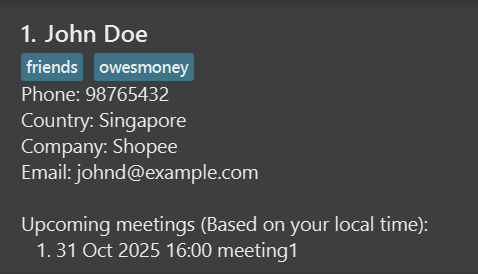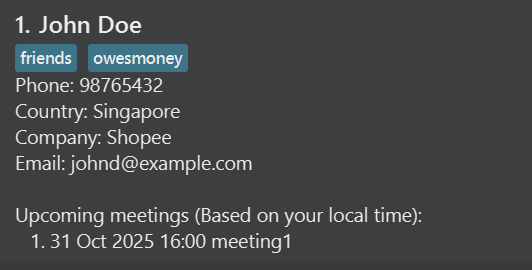Duplicate Meeting Bug: Not Displayed In Contact Card
Hey guys! Today, we're diving deep into a peculiar bug we've discovered in our application. It revolves around duplicate meetings and how they're displayed (or rather, not displayed) in the contact card. So, grab your favorite beverage, and let's get started!
Discussion Category
- AY2526S1-CS2103T-T15-4
- tp
Additional Information
Here’s the lowdown: When a user tries to add a meeting that's a duplicate of an existing one for a contact, the system, like a responsible gatekeeper, asks for confirmation. However, even if the user confirms adding the duplicate, only one meeting shows up in the contact card. This can be super confusing, especially since the user explicitly chose to add the duplicate. Imagine planning a surprise party and then only half the guests show up in the invite list – total chaos, right?
Steps to Reproduce
To see this bug in action, follow these steps:
-
Initial Meeting: First, add a meeting for a contact at INDEX 1 using the command:
addm 1 m/31-10-2025 16:00 meeting1. This sets the stage with an initial meeting.
-
Duplicate Meeting: Next, try adding a duplicate meeting with a slightly different description. Use the command:
addm 1 m/31-10-2025 16:00 NewMeeting. Notice the date is the same as the existing meeting, but the description is different. -
The Warning: The system will detect the duplicate meeting and prompt you with a warning:
Warning: A duplicate meeting already exists in the address book. Please confirm if this meeting should still be added. Enter 'y' to confirm or enter any other input to cancel.
-
Confirmation: Enter
yto confirm that you indeed want to add the duplicate meeting. You should see a confirmation message:New meeting added for John Doe: 31 Oct 2025 16:00 NewMeeting
-
Check the Contact Card: Now, view the contact card for John Doe. You’ll notice that only the originally added meeting (with the old description) is displayed. The duplicate meeting, which you just confirmed, is nowhere to be found!
Expected Result
Ideally, both meetings – the original and the duplicate – should be visible in the contact card. This would reflect the user’s conscious decision to add a duplicate meeting, making the system intuitive and reliable. After all, if a user confirms something, the system should honor that decision!
Actual Result
In reality, only one meeting is shown in the contact card. The duplicate meeting, despite being confirmed and supposedly added, is missing in action. It’s like a magician making something disappear, but not in a cool, entertaining way. More in a frustrating, “where did my meeting go?” kind of way.

Why This Matters
This functionality bug can lead to significant user confusion and potentially missed appointments. Imagine a scenario where a user intentionally schedules two meetings with the same person on the same day but with different agendas. If only one meeting is displayed, the user might forget about the other, leading to professional embarrassment or missed opportunities. Consistency in displaying what the user has explicitly added is crucial for maintaining trust in the system. It is a medium severity bug.
Possible Causes
So, what could be causing this? Here are a few educated guesses:
- Data Overwrite: The system might be overwriting the existing meeting data with the new duplicate meeting data instead of creating a new entry. This would explain why only one meeting is visible.
- Unique Identifier Conflict: There might be a conflict in how the system generates unique identifiers for meetings. If the duplicate meeting is assigned the same identifier as the original, it could be causing the system to treat them as the same entry.
- Display Logic Error: The issue might not be in the data storage but in the display logic. The contact card might be programmed to only show one meeting per time slot, regardless of how many meetings are actually stored in the database. This is a potential functionality bug.
- Synchronization Issues: If the application uses caching or synchronization, there might be a delay in updating the contact card with the new duplicate meeting. This delay could lead to the user only seeing one meeting initially.
Potential Solutions
Now that we've identified the problem and speculated on the causes, let's brainstorm some potential solutions:
- Ensure Unique Identifiers: Double-check the logic for generating unique identifiers for meetings. Make sure that each new meeting, even if it's a duplicate, gets a unique ID.
- Modify Data Storage: Review the data storage mechanism to ensure that it can handle multiple meetings with the same date and time. If the current structure only allows for one meeting per time slot, it needs to be updated.
- Update Display Logic: Adjust the display logic for the contact card to show all meetings associated with a contact, regardless of the date and time. This might involve modifying the query that fetches meeting data or the way the data is rendered on the card.
- Implement Proper Synchronization: If caching or synchronization is involved, ensure that the contact card is updated promptly whenever a new meeting is added. This might involve using callbacks or event listeners to trigger a refresh of the card.
Preventing Future Bugs
To prevent similar bugs from cropping up in the future, consider the following:
- Thorough Testing: Implement comprehensive testing procedures that specifically check for duplicate entries and edge cases. This should include both unit tests and integration tests.
- Code Reviews: Conduct regular code reviews to catch potential issues early on. A fresh pair of eyes can often spot mistakes that the original developer might have missed.
- User Feedback: Encourage users to provide feedback on the application. Real-world usage can often uncover bugs that were not caught during testing.
- Clear Requirements: Ensure that the requirements for the application are clearly defined and well-understood by the development team. This can help prevent misunderstandings that lead to bugs.
Conclusion
In summary, the duplicate meeting bug is a significant issue that needs to be addressed. By understanding the steps to reproduce the bug, identifying the potential causes, and implementing appropriate solutions, we can improve the user experience and ensure that the application behaves as expected. And remember, folks, a well-tested and reliable application is a happy application!
Thanks for tuning in, and happy debugging!
Labels: severity.Medium type.FunctionalityBug